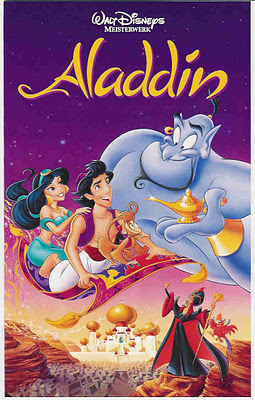This review previously appeared at Bitch Flicks as part of our series on Animated Children’s Films.
This movie is about a princess and a “street rat” who fall in love and must overcome the evil Jafar to get married. This movie is also about generalizing non-Western cultures (mainly Middle Eastern cultures) and perpetuating cartoonish stereotypes of Arabic peoples. As an added bonus, this movie masquerades as a girl power film when in fact, it enforces the traditional gender role of men as active/women as passive.
The first time I saw this children’s movie was over this past summer, when I was the assistant director of a summer production of the musical Disney’s Aladdin. I was the only person involved in the production that had not seen Aladdin when I was a child. Every single one of the children (almost entirely girls, ages 9-12 with one 7 year old) came in with ideas of what the show would look like, because they had all seen the movie and they knew every single song. Because they knew the music, we had more time to work on choreography. For a marketplace scene, I asked the kids to strike a pose to freeze in during dialogue. I was looking for marketplace-y poses: two people talking, maybe gesturing to another person, walking poses, etc. They immediately put their arms up with their palms together so that their arms framed their face and their necks were moved to one side (a pose associated with “Arabia” in pop-culture). They all wanted to do their hair in the “I Dream of Jeannie” hairdo, because it was “so Arabian”. I wondered, where did they get such a stereotypical view of the Middle East? And then I saw the movie and all of those questions were answered.
My director thought that this was a girl power movie. Look! At the end, the Sultan declares that Jasmine can marry whomever she chooses, when she chooses! And she rejects all of those suitors because she’s “not a prize to be won”! Girl power yeah! No. This movie is producing yet another hetero-romantic story where women sit there and men pursue them. She was naïve before Aladdin shows her a “whole new world”—she is the passive learner while he is the active teacher. How does she help with the defeat of Jafar? She kisses him—using her body to be attractive to men—the rest of the time she just kind of stands there while Aladdin fights Jafar. Again, she stands there lookin’ sexy and being passive, he fights actively. Even their body stance around each other assumes a dominant/submissive look—Aladdin’s body is tall and upright, Jasmine is leaning into him or sitting behind him or being held in his arms. He is also physically larger, aside from her hair (her ponytail is thicker than her waist), she is extremely thin and takes up very little space when compared to Aladdin’s broad shoulders and muscular body. And of course, what other characters in this movie are women? Oh that’s right, they are all men. Because women can only be in stories to be the object of men’s affections, not to fill other roles. There are some background women in the dance scenes, but those are the “harem girls” and other sexualized women (because foreign=exotic and sexy!)
Essentially, all of the women are defined by their attractiveness to men. “Ugly” women, then, are used as comic relief. In one of the first scenes, when a woman opens the door and says of Aladdin, “Still I think he’s rather tasty!”, everybody in the audience is supposed to laugh. Aladdin looks at the woman (who is quite large) and jumps in surprise and disgust. Oh, silly fat woman, you can’t have feelings because you’re ugly! We’re supposed to laugh at how ridiculous her thinking Aladdin is “tasty” is—because fat women and ugly women are not supposed to have sexual desires. Only when the sexy women do this is it okay—nobody is laughing at Jasmine’s proclamations of love for Aladdin, because it doesn’t seem ridiculous now. Aladdin is attractive, she is attractive, so they can be in love.
So doing this story where every single role had to be filled by a girl made this an interesting production. Some girls told us they didn’t want to be a male character. Some girls who were cast into men’s roles started acting like men—they lowered their voices and changed their body language to reflect a stereotypical man. Some girls who were cast into men’s roles adopted them to be women’s roles—the girl playing Jafar, for example, had no issue with being a female Jafar. The girl who played Aladdin, the title character, made it clear that she was acting like a man—I, personally, thought that it would have been fine for her to be a female Aladdin (but the lesbian love story was not an idea that they particularly were comfortable with, which is interesting given how comfortable they were with heterosexual love stories).
In fact, I think it would have made the movie better if Aladdin was a girl (and if all the racism was taken out). Suddenly, “A Whole New World” takes on a whole new meaning—but these movies with antiquated gender roles would not have been as widely accepted into culture if the relationship it portrayed was queer.
When watching this movie, it’s hard to not get depressed about the fact that this is what little girls are told to aspire to. Watch something else instead.
This is an anonymous review.




Pretty much agreed with all of the above, but….but…
I actually really liked Jafar. He was one of my favorite characters ever when I was a kid.